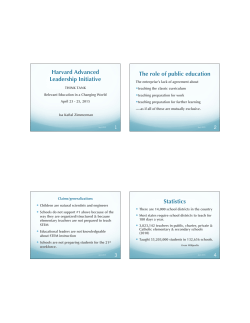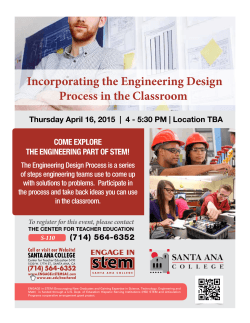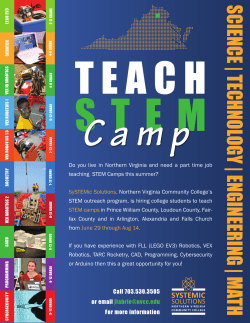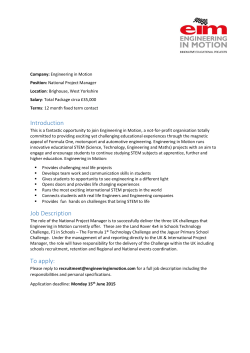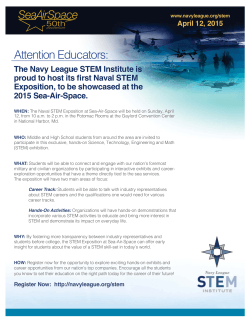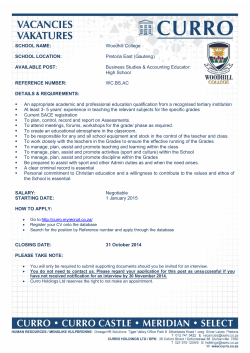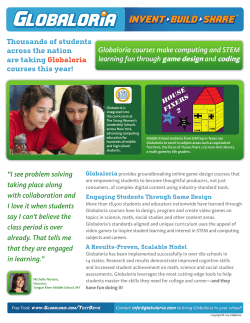
SPRING STEM INSTITUTE Session Descriptions
SPRING STEM INSTITUTE STEM education is an approach to learning that removes the traditional barriers separating the four disciplines (science, technology, engineering, and mathematics) and integrates them into real-world, rigorous, relevant learning experiences for students (Vasquez, Jo Anne. STEM Lesson Essentials, 2013). The purpose of STEM education is for all learners, including girls and underrepresented populations in STEM careers, to achieve literacy in the core disciplines, become critical thinkers and masters of 21st Century skills, and ready and motivated to successfully pursue college preparation and careers related to STEM. With generous support from the GE Foundation, the NYC Department of STEM is excited to offer the first of three STEM Institutes, for teacher teams (2 to 3 educators), over the 2014 – 2016 school years. During the first three-day Spring STEM Institute, which will take place at Stuyvesant High School from Tuesday, April 7 to Thursday, April 9, 2015, teacher teams will have an opportunity to: • • • • Develop a shared understanding of the important features of STEM education Develop an awareness of different approaches to STEM education Build their leadership capacity to support STEM education within their school communities Build an ongoing theme-based collaborative community of schools to support STEM education Session Descriptions SPRING STEM INSTITUTE ......................................................................................................................................................................... 1 1. Health and Wellness: NaliniKIDS (Grades 6-8) ............................................................................................................................ 2 2. Health and Wellness: Recycle a Bicycle (Grades 8-12).............................................................................................................. 3 3. Environment and Sustainability: Grow to Learn NYC ................................................................................................................ 4 4. Environment and Sustainability: NYC Eco-Schools (Grades K-12) ....................................................................................... 4 5. Environment and Sustainability: Solar One ................................................................................................................................... 5 6. Engineering and Design Thinking: Cooper Hewitt ...................................................................................................................... 5 7. Engineering and Design Thinking: Engineering is Elementary (grades K-2) ................................................................... 5 8. Engineering and Design Thinking: Engineering is Elementary (grades 3 to 5) ............................................................... 6 9. Engineering and Design Thinking: Making & Analyzing Wind-up Vehicles (Grades 2-5) ........................................... 6 10. Engineering and Design Thinking: Modeling our Worlds ...................................................................................................... 7 11. Engineering and Design Thinking: The National Building Museum (Grades 5-9) ....................................................... 8 12. Engineering, Design Thinking and Architecture: City College - Gaudi Exhibit (Grades 5-8 and 9-12) ................ 9 13. Computer Science/Robotics: Boot Strap - Video Game Programming with Algebra (Grades 6-12) ................. 10 14. Computer Science/Robotics: LEGO Education (Grades 1-5) ............................................................................................. 11 15. Computer Science/Robotics: NYC FIRST Robotics ................................................................................................................ 11 1. Health and Wellness: NaliniKIDS (Grades 6-8) NaliniKIDS is a student generated inquiry based program that merges experiences from major content areas and allows students to collaborate with peers and teachers and utilize community resources to solve problems. The holistic and academic mind/body approach truly makes NaliniKIDS unique. Columbia University has conducted a longitudinal research study of the NaliniKIDS program, examining the aspects of the program related to physical fitness and emotional literacy and how it might contribute to improved attention, selfefficacy and self-control in student groups. NaliniKIDS appreciates and is intrigued by the most commonly accepted definition of weight: Weight: 1) a body's relative mass or the quantity of matter contained by it. 2) the heaviness of a person or thing. Interestingly enough, pounds are not mentioned in this definition. In fact, weight is not about the scale; that's our society’s interpretation. Given that insight, a child or an adult can be very fit and still be heavy. We believe that emotional weight can be just as alarming and detrimental as unhealthy physical weight. A person could be slim physically, but their aura and demeanor could make it seem like they have packed on an additional hundred pounds! NaliniKIDS aims to tackle both healthy physical and emotional weight. NaliniKIDS runs an in-school wellness intervention program designed to address both the physical and emotional aspects of a student's well-being. The method behind the program combines a physical fitness regimen with a mindfulness-based emotional literacy component. Through precision based workouts and creative and insightful discussion, teachers and students learn strengthening techniques for both body and mind. Through training in our signature NaliniKIDS curriculum, you will engage in the first-ever emotional diet through emotional literacy and a One Word workout, based on founder Rupa Mehta’s book, Connect to Your One. (Required Reading). During the 3-day workshop, we will thoughtfully teach you to uncover how our emotional health quality can be improved by reducing the consumption of heavy words and phrases such as those high in self-destructiveness and abuse, and by increasing the intake and realization of words high in clarity and potential. You will engage with textual material through journaling, visual art projects, and reflective writing exercises (based on a teacher's instructional manual) that allows not only yourself, but also your students to develop strategies of emotion regulation, cognitive reappraisal, problem- solving skills, and empathy -building. You will be thoroughly trained to teach the physical regimen as well (note: a video will be available for your students to follow). The One Word Workout integrates strength training, yoga, and pilates-based exercises to promote movement and physical health. Required Reading: Connect to Your Oneby Rupa Mehta (must read prior to workshop) All teachers interested in teaching the NaliniKIDS program will receive training from NaliniKIDS founder Rupa Mehta as well as support from 5-8 seasoned NaliniKIDS volunteers. With the book, Connect to Your One, and innovative curriculum teachers can: • • • Adhere to the Common Core and English/Language Arts requirements, while also teaching students valuable life lessons. This leads to more efficient use of class time! Increase their own skillset and get trained in this specialized curriculum Take an academic approach to non-academic subjects of physical education/emotional literacy • • • • Customize and adapt the program to engage students from all different backgrounds, learning styles and reading levels Connect lessons to meaningful physical activity that reaffirms the link between physical and emotional fitness Capitalize on far-reaching lessons that have multiple paths to “right” answers by encouraging exploratory yet structured plans Benefit from curriculum that caters to both individual and team learning To participate in this breakout, we recommend you wear/bring: • • • Comfortable clothes and sneakers for learning/doing physical routine Notebook and writing utensil Bottle of water 2. Health and Wellness: Recycle a Bicycle (Grades 8-12) Recycle-A-Bicycle (RAB) is a 501 (c)(3) nonprofit organization that utilizes the bicycle as a resource to foster youth development, environmental education, community engagement, and healthy living. Through retail storefronts, social entrepreneurship, and innovative programs, RAB empowers the youth of New York City and beyond. Currently, the organization offers technical assistance to 32 NYC public schools, which includes teacher training, bicycle/tools procurement, and the sharing of bicycle education information and grant opportunities through a monthly newsletter. Bike New York is a 501(c)(3) nonprofit and New York City’s leading proponent of cycling as a practical, sustainable, and healthy means of transportation and recreation. We offer free bike education programs throughout the five boroughs, whereby we teach kids and adults how to ride a bike, and how to do so safely and confidently in the city. In 2014 alone, we taught bike skills to 16,000 New Yorkers. Bike New York organizes numerous annual events, including the TD Five Boro Bike Tour (the world’s biggest charitable bike ride), Bike Expo New York, and smaller regional and community rides. Concept Over the course of the STEM Spring Institute, Bike New York and Recycle-A-Bicycle will work with 25 teachers interested in cycling curricula as it relates to mathematics for grades 6-12. On the first morning, our two organizations will describe the resources they have to offer and ways in which they currently work with schools. In the afternoon, the participants will be divided into two groups and each group will receive five hours of experiential learning in safe cycling and bike repair. During the final two hours, the two groups will be brought together to review math curricula and be invited to discuss new ideas for relating cycling to mathematics. Class Pre-requisite Participants must know how to ride a bicycle and be willing to cycle outdoors for part of the workshop. Stuyvesant High School is ideally located to teach about cycling, since it is located right on the Hudson River Greenway. It is recommended that participants bring their own bike in good working condition and a bicycle helmet. However, if a bicycle is not available, participants may sign up to borrow a bicycle. Participants must provide their in-seam and height in order to get the proper size bicycle for use in the workshop. Participants do not need to have any prior bicycle repair experience. Bicycles, tools and supplies will be provided for participants in the repair class. Recycle-A-Bicycle Maintenance and Repair Workshop The repair workshop will describe how to set-up a school bicycle program and will select a few lessons, taken from its 10 week program, introducing basic repairs that most specifically relate to mathematics: Participants will focus on the drive train and be asked to overhaul a bottom bracket, replace gear cables, and adjust the derailleur. These repairs all relate to the gear ratio of the drive train, and will tie into the final discussion on mathematics curricula. Bike New York Youth Bike Skills Curriculum Workshop Bike New York has a very well-developed bike skills and safety curriculum, which includes teaching kids how to ride for the first time; basic bike handling skills; and traffic safety knowledge. The curriculum includes cocurricular units on the history and heritage of cycling, including important technical developments, and important multi-cultural moments in the history of cycling. The curriculum also has co-curricular mathematics units that address technical, safety, economic, and environmental aspects of cycling. Shared Resources Each participant will receive a copy of: • • One Revolution at a Time (publication by Recycle-A-Bicycle and Bike New York) The NYC Bike to School Program Bicycle Repair Curriculum (digital version) 3. Environment and Sustainability: Grow to Learn NYC Interested in starting a school garden at your school, but aren’t sure how to begin? Looking for ways to make your garden a center for hands-on, inquiry-based learning? Join Grow to Learn staff for an exciting workshop focused on planning, building, and using a school garden. We’ll cover all the gardening basics (mapping and planning, garden types and building, planting, maintenance, and harvesting) plus engaging STEM activities to use with students. This workshop is open to K-12 schools that either currently have or are planning a school garden of any type (indoor, outdoor, hydroponic, etc). It is recommended that attendees bring a laptop to the workshop and come prepared with possible space(s) at their school for a garden and approximate dimensions of that garden space. School teams will leave this workshop registered with Grow to Learn (making them eligible to apply for Grow to Learn Mini-Grants and receive free gardening materials), prepared to begin a school garden project, and armed with STEM activities to incorporate into classroom gardening! 4. Environment and Sustainability: NYC Eco-Schools (Grades K-12) Green STEM blends traditional STEM with environment-based education and emphasizes project-based learning and real world problem-solving. Research and experience have shown that environment-based - and specifically outdoor - education improves students’ motivation to learn and enhances academic achievement in all subjects. Join NYC Eco-Schools for an exciting, hands-on program that will show you how to take learning outdoors. Discover how teachers are using the Eco-Schools USA program to create wildlife-friendly gardens and restore pollinator habitat at a local refuge. Learn how to create a container-based butterfly garden in your school; plant some pollinator-friendly seedlings; make “insect hotels;” and upload plant and pollinator phenology data to a national citizen science database using mobile apps. You’ll make “seed bombs,” and learn how to make mini starter greenhouses to grow native grasses that can be planted to restore degraded ecosystems. We’ll conclude with a tour of a local soil science lab and organics processing facility that makes compost and “compost tea” to nourish the soil in a local park. Participants will leave with their very own native plant seedlings, seed bombs, and fabulous curriculum resources for use in and out of the classroom! Please dress appropriately for the weather, including comfortable shoes and clothing. 5. Environment and Sustainability: Solar One Explore hands-on activities from Solar One's Green Design Lab curriculum! The Green Design Lab uses the school building as both a learning laboratory and a tool for environmental change. The lessons promote realworld STEM learning and school sustainability through a close study of 5 areas: Energy, Water, Food, Materials, and Air Quality. During the training teachers will; participate in hands-on STEM activities such as wind turbine design and battery building, develop customized lesson plans to fit the needs of different subject areas, and learn best practices for integrating sustainability and environmental science across disciplines. All participants will be provided with Solar One resources including curriculum and lesson plans, standards alignment, field trip opportunities, and technical support from Solar One Educators. 6. Engineering and Design Thinking: Cooper Hewitt Cooper Hewitt, Smithsonian Design Museum will offer an interactive 3-day workshop for K-12 educators, introducing design thinking as a vehicle for creative problem-solving across curricula. Educators will 'play designer' and take on the tasks of brainstorming, prototyping and presenting solutions to open-ended challenges under time and material constraints. Over 60,000 New York City students have already experienced this introduction to design thinking, which promotes essential skills such as creative problem-solving, collaboration, and oral presentations. In addition to hands-on activities, Cooper Hewitt will present a range of resources, including the Educator Resource Center, which features over 400 free standards-based, design-focused lessons written by K-12 educators from across the country. Upon completion of this workshop, educators will be able to use designbased teaching and learning in their classrooms and implement a variety of a hands-on activities that connect to project-based learning, STEM disciplines, 21st Century Skills, and Common Core Standards. Join us and see how our rich collection, diverse resources, and unique approach to design thinking can inspire you! About Cooper Hewitt, Smithsonian Design Museum Founded in 1897, Cooper Hewitt, Smithsonian Design Museum is the only museum in the nation devoted exclusively to historic and contemporary design. The museum educates, inspires and empowers people through design, presenting compelling educational programs, exhibitions and publications. International in scope and possessing one of the most diverse and comprehensive collections of design works in existence, the museum's rich holdings range from Egypt's Late Period/New Kingdom (1100 B.C.) to the present day and total more than 210,000 objects. 7. Engineering and Design Thinking: Engineering is Elementary (grades K-2) The Engineering is Elementary Teacher Educator Institute is hands-on and learner-driven. You’ll develop a deep understanding of the pedagogy and structure of the EiE curriculum. And you’ll take away a large collection of valuable resources to help you facilitate your own EiE workshops and support teachers as they implement EiE in their classrooms. During this workshop, you will • • • • Gain foundational knowledge of technology, engineering, and the engineering design process. Reflect on the facilitation strategies and the philosophical underpinnings of what makes a quality, integrative engineering curriculum. Become familiar with the EiE curriculum, including the structure of the units and the pedagogical approach. Experience two different EiE units as a learner and as a teacher. This workshop is specifically designed for grades K through 2nd. 8. Engineering and Design Thinking: Engineering is Elementary (grades 3 to 5) The Engineering is Elementary Teacher Educator Institute is hands-on and learner-driven. You’ll develop a deep understanding of the pedagogy and structure of the EiE curriculum. And you’ll take away a large collection of valuable resources to help you facilitate your own EiE workshops and support teachers as they implement EiE in their classrooms. During this workshop, you will • • • • Gain foundational knowledge of technology, engineering, and the engineering design process. Reflect on the facilitation strategies and the philosophical underpinnings of what makes a quality, integrative engineering curriculum. Become familiar with the EiE curriculum, including the structure of the units and the pedagogical approach. Experience two different EiE units as a learner and as a teacher. This workshop is designed for grades 3 to 5. 9. Engineering and Design Thinking: Making & Analyzing Wind-up Vehicles (Grades 2-5) Participants will develop an understanding of both the differences between science and engineering, as well as connections between them, through hands-on design and analysis of rubber-band-powered vehicles. These wind-ups are easily assembled from readily available materials, such as paper cups, plastic lids, skewers, paper clips and pony beads. During the first day, participants will engage in a preliminary activity to elicit and explore basic distinctions between science inquiry and engineering design. Subsequently, they will be introduced to a variety of windups, and challenged to make their own. Because their wind-ups may not work immediately, the group will develop troubleshooting techniques and create a troubleshooting chart, which identifies common issues, their possible causes and ways to fix them. The day will conclude with an exploration of ways of representing windups through drawings and diagrams. On the second day, the participants will begin by revisiting the wind-ups they have already made. There will be an initial discussion of how a wind-up works, focusing on the energy relationships: Where does the energy come from, how is it stored and transformed, and what form does it take it each step in the process? Next, they will identify differences among them, and identify variables that might affect their performance, such as wheel size(s), distance between the wheels, weight, type of rubber band, and number of winds. The day will conclude with the planning and implementation of a controlled experiment to determine how the sizes of the wheels affect the distance a wind-up travels. Participants will collect and analyze the data, and try to make sense of the results. The third day will begin with a review of the previous day’s experiment, followed by the design and conduct of a second experiment to determine the effect of the number of turns of the rubber band. During the afternoon, participants will take on a variety of challenges: creating a wind-up that goes in circles of various diameters; making one that can climb a ramp; designing and building a car or train using a wind-up mechanism; and making a device that returns to its starting position. The day will conclude with an extended discussion of how these activities might be implemented in the classrooms of the participants. All participants will receive a printed version of the Fantastic Elastic curriculum, which the workshop is based on, plus a generous supply of materials for making their own wind-ups. Organizational Background The City Technology Project at the City College of New York has been awarded four major National Science Foundation grants to create and test hands-on materials that integrate science and engineering in the elementary grades. The most recent funded project, Physical Science Comes Alive, was led by two City College Faculty, from the Schools of Education and Engineering, respectively, and a Professional Learning Community of 12 NYC elementary teachers who are engaged as co-designers of curriculum and professional development, conference presenters and co-authors of published papers. The project has resulted in the development of eight curriculum units, which are available on the project web site, www.citytechnology.org, under Energy Systems and Force & Motion. The units are supported by print materials as well as hundreds of short videos illustrating every component of the curriculum. The printed versions include alignments with the Common Core Learning Standards *CCLS) for Mathematics and ELA, Math and both science and engineering components of the Next Generation Science Standards (NGSS). Presenters Emmy Matias-Leonard Professor James L. Neujahr Joaquin Rodriguez 10. Engineering and Design Thinking: Modeling our Worlds In this three-day workshop, Kara Imm (Co-Director of Math in the City), will lead participants through a series of investigations and related activities to develop their ability to lead rich modeling tasks with their middle or high school students. Drawing upon research from the models and modeling paradigm, as well as her own recent study of high school “repeaters,” Kara will ensure that participants: • • • • • • Have a working definition of mathematical modeling and understand its recent resurgence in K-12 classrooms Can distinguish between problem solving and modeling, and can name the unique features of modeling Leave with a set of tasks/investigations to use with students, and ideas about how to design their own investigations for their particular community Have experienced and witnessed (e.g., video) the phases of mathematical modeling and have thought about them in relation to the scientific method Know the benefits and challenges of implementing modeling with kids Develop collaborative relationships with other modeling-minded educators across New York City All materials will be provided, but participants are strongly encouraged to bring a graphing calculator and notebook each day. 11. Engineering and Design Thinking: The National Building Museum (Grades 5-9) DAY ONE The Bridge Basics Program Kit uses creative hands-on activities to teach why and how we create bridges and other structures. Bridge Basics’ fun and engaging activities address student academic achievement in core disciplines of math, science, technology, and engineering. Objectives include encouraging youth to consider careers in high-demand industries such as construction and engineering, which are crucial to our nation’s economic future. Bridge Basics teaches fundamental structural engineering concepts through interdisciplinary activities and lesson plans. Students in grades 5 – 9 are challenged to design, test, construct, and evaluate solutions to transportation problems. The curriculum meets national standards of learning in math, science, engineering, visual arts, and social studies. The curriculum program kits come ready to use, and include a CD-ROM with an interactive activity, lesson plans, worksheets, posters, model construction materials, and other resources. Bridge Basics can be used by a variety of instructors, such as school classroom teachers, youth group leaders, or building professionals. Agenda • • • • • • • • • • Introduction to the National Building Museum and design education Goals and objectives of the Bridge Basics Program What is a bridge? Teaching about loads and forces Taking a look at bridge aesthetics Case studies: beam, arch, and truss bridges Case studies: suspension and cable-stayed bridge Model lesson plan: Build a functional model bridge Brainstorm ways to use the bridge engineering and design education in your classroom Question and answer DAY TWO The Green Community Teaching Kit provides a comprehensive approach to studying how green, sustainable communities can be created and maintained. Students create a town from the ground up complete with model buildings, land use categorization, and regional planning strategies. Like the Museum's other educational programs, students create their own community by following the steps of the design process. Through this process, students develop skills such as communication, cooperative learning, decision making, analysis, creativity, and innovation. The Kit introduces students to the town of Grayville, a fictional community synthesized from a combination of real-life case studies. While studying the problems of Grayville, students are introduced to the basics of urban planning including land use and zoning. Students then explore the principles of sustainable communities through the investigation of real life towns and cities and through an examination of green buildings featuring sustainable technologies. They then use these concepts to re-plan Grayville into a new, livable, sustainable community named Greenville. The curriculum is aligned to national standards of learning in the English language arts, mathematics, science, social studies and visual arts. The Kit includes a 53' by 53''map, lesson plan booklet, and visual aids, all of which are made out of durable, environmentally-friendly materials. The Kit is designed for students in grades 5-8. Agenda • • • • • • • • Introduction to the National Building Museum and design education Defining: What is green? City planning basics: land use and zoning Green basics Case studies: Great green places Model lesson plan: Incorporating green buildings into the urban landscape Share ways to use the design process in your classroom Question and answer DAY THREE This course will introduce educators to the world of disaster mitigation, through the lens of design. They will use strategies employed by professionals in the architecture, construction, engineering, and urban planning disciplines to lessen damages from natural disasters. Each of the natural disasters studied (including flooding, storm surge, wind from hurricanes and tornadoes as well as shaking from earthquakes) has a unique effect on the built environment. After completing Designing or Disaster, students will be able to describe and demonstrate basic physical forces which act on buildings such as compression, tension, and shear force. They will review photographs of structural damage from historical natural disasters and decide how to fortify structures in order to prevent future damage. They will also profile resilient structures and handle actual construction materials that are used to blunt the impact of destructive forces. Designing for Disaster is best aligned for students in grades 7-9 and is compliant with Common Core State Standards Initiative and the Next Generation Science Standards. The curriculum and materials in the Kit are designed to be reused year after year. Agenda • • • • • • • • • Introduction to the National Building Museum and design education Defining resilience Teaching about loads and forces Measuring risk Visual thinking strategies: Investigating photographs City planning basics: Considering flood zones Where to reinforce? Importance factor Case studies: Examining resilient structures and materials Question & Answer 12. Engineering, Design Thinking and Architecture: City College - Gaudi Exhibit (Grades 5-8 and 9-12) Teachers will first gain qualitative and intuitive understanding of mathematical curves and surfaces through a variety of analytic and building tools: graham cracker arches, Geometer’s sketchpad, paper folding, and good old-fashioned pencil and paper. They will focus on transformational geometry, as explored in the Common Core Standards. The 5-8 and 7-12 group will meet together for an exploration of Catalan architect Gaudi’s Sagrada Familia Basilica now on exhibit at the Bernard and Anne Spitzer School of Architecture. We will model a series of language (including mathematical language) and visual literacy (including mathematical visual literacy) building exercises in the gallery. The two grade bands will separate for the mathematical content oriented part of the workshop. This will be followed by analysis of those same forms with the goal of increasing computational fluency. Presenters Sunita Vatuk, Professor of Secondary Math Education at CCNY Laura Gellert, Professor of Elementary Math Education at CCNY Marc Donnelly, Architect 13. Computer Science/Robotics: Boot Strap - Video Game Programming with Algebra (Grades 6-12) Bootstrap is a curricular module for students in grades 6-12, which teaches algebraic and geometric concepts through computer programming. At the end of the module, students have a completed workbook filled with word problems, notes and math challenges, as well as a video game of their own design, which they can share with friends and family. You can learn more about Bootstrap here. The eight units of the curriculum are aligned to the Common Core Standards for Mathematics. All teachers will receive a workbook with printed lesson plans. We also provide teachers with exercises, assessments, a student workbook, and ongoing support throughout teaching. In this three day workshop, we will explore the research and pedagogy behind the curriculum, investigate the cognitive challenges for students struggling with algebra, and practice the entire curriculum together from start to finish. By the end of the workshop, you will go home with a video game that you have created! Below, we’ve included a day by day breakdown of the agenda. The only equipment you will to bring to the workshop is a laptop with a modern internet browser installed. On the first day of the workshop, we will break down the elements of a simple video game and begin to discuss the connections between programming functions and algebra. We will become familiar with the syntax of the Racket programming language and use a tool called the “Circle of Evaluation” to break down arithmetic expressions by the order of operations and then translate them to Racket code. We will discuss domain and range as they relate to both computer programming and algebra and use these concepts to begin to program our own functions using algebraic equations and images. On the second day, we will discuss a strategic method for solving these word problems called the “Design Recipe.” This process will can be applied to questions in both computer science and algebra. We will use the Design Recipe to write linear functions to make characters in our games move. We will then discuss inequalities in the Cartesian plane as it relates to our video games, and use functions with inequalities to keep characters in our games within certain limits on the screen. Before the end of the day, we will solve word problems that write piecewise functions. These functions will allow us to program event-driven behavior into our game. As we program throughout the day, we will be emphasizing engineering practices such as code documentation and test cases. We will also make concrete connections between the computer programming aspect of the curriculum and the mathematical concepts we are teaching. On the final day of the workshop, we will discuss the distance formula and program a function to find distance using the Design Recipe. We will then combine this with our discussion on inequalities to add collision detection to our game. After the game is finished, we will discuss how Bootstrap can be integrated into various classroom settings. We will have a chance to practice the pedagogy of the curriculum in small groups. Before the end of the day, we will cover differentiation for various skill levels and talk about curriculum options that expand beyond Bootstrap. 14. Computer Science/Robotics: LEGO Education (Grades 1-5) LEGO® Education Presents A Customized Project-Based STEM Learning Environment for NY Schools Join us for three days of hands-on, minds-on learning in a unique STEM Environment for first through fifth grades. Participants will experience how LEGO® MoreToMath 1-2, Simple Machines, WeDo Robotics, and LEGO Education StoryStarter can be comprehensively used to support a highly motivated STEM learning environment. Specific emphasis will be placed on the development of skills, discovery, and creative problemsolving. Practical methods of assessment and classroom management will be addressed This exciting hands-on learning experience will immerse participants in the awesome possibilities of LEGO Education. Participants should be able to integrate LEGO’s unique learning philosophy with their current instructional tool set. The breadth of STEM concepts will be addressed. Participants having been grouped into teams of two will experience firsthand how LEGO Education products: • • • Complement the instruction of math skills and problem-solving strategies with MoreToMath 1-2 Introduce students to physics concepts with Simple Machines. Expand on physics concepts and apply them to a practical exploration of robotics, programming, math, and science with WeDo. To summarize the learning at the end of day three, participants will utilize LEGO StoryStarter to create a 3-D story board of ideas to express their overall understanding of the workshop experience. This will be achieved through the development of a collaborative language arts product that tells the narrative of each team’s unique workshop experience of Science, Technology, Engineering, and Math discovery. Teachers will capture pictures and their experiences over the two and a half days which we will put into StoryVisualizer to create a PDF of their learning and how they will integrate LEGO Education into their classrooms making this a true hands-on experience. Teams will benefit from the opportunity to share these products and collaboratively plan how to use these materials in their own classrooms. 15. Computer Science/Robotics: NYC FIRST Robotics This workshop will provide teachers with the skills necessary to get involved in FIRST LEGO League and start a team in their school. The workshop will be led by Peter Xanthus, an experienced Robotics instructor and cochair of the FIRST LEGO League in NYC. All participants will be given a LEGO Robotics set to bring back to their school. All that you need to bring is a laptop. Day 1: Build an autonomous Robot capable of completing tasks on an obstacle course. Robots will include light, touch, color and other sensors. Day 2: EV3 Robot Programming – includes programming the robot to behave autonomously, as well as use sensors to navigate the obstacle course Day 3: Advanced Programming and then a “Spring Break PD FIRST Robotics Competition!” Participating teachers will test their skills in a mock Robotics tournament with the winners being awarded additional robotics materials.
© Copyright 2025
